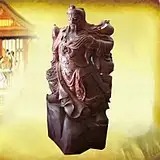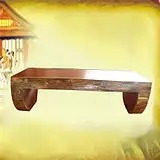Root carving materials must be selected from tree species with hard material, fine wood, stable wood properties, not easy to crack and deform, not rotten and immortal, and can be preserved for a long time. The selection criteria for root material shapes can be summarized as "rare, strange, ancient, and strange". Such materials are extremely rare in nature. Generally, tree roots growing in plains or mountains with thick soil have sufficient water and nutrients, grow fast, and the wood fibers are loose, making it difficult to form strange shapes. Only roots growing in harsh environments, such as growing in the shade or in the cracks of cliffs, and tenaciously surviving after lightning, fire, ant erosion, stone pressure, human trampling, and knife cutting, will not gradually deform over time due to insufficient light, lack of soil, water, and lack of nutrients. The longer the years, the harder the quality, and the more bizarre and vigorous the shape, which is the ideal material for root art. Rosewood
, Torreya grandis, camphor wood, and lychee wood are rare varieties of root carving wood; boxwood, sandalwood, beech, cypress, elm, etc. are the best material varieties of root carving wood.
Rosewood is not the same kind of wood. One refers to old rosewood, and the other refers to new rosewood. Old rosewood is also called Huanghuali, which has moderate material, warm nature, no deformation, fragrance, orange-yellow color, red-purple, and deep and light patterns like raccoon spots. Most of the high-end and sophisticated furniture in the Ming Dynasty was made of Huanghuali. Because the texture of old rosewood is beautiful, craftsmen often use a smooth treatment throughout the body without carving to highlight the natural beauty of the wood texture. Huanghuali furniture is extremely gorgeous, and those that have been passed down to the present have extremely high appreciation and collection value.
New rosewood is also called grass rosewood. It is reddish yellow, loose in color, with coarse brown eyes, stripes, and no luster. The material is far inferior to that of old rosewood. According to industry insiders, the yellow rosewood tree is now extinct, so modern furniture made of rosewood is all new rosewood.
Rosewood is produced in Guangdong and Guangxi, but in small quantities. The "Bowu Yaolan" says: "The rosewood is produced in Jiao (Jiaozhi) Guang (Guangdong and Guangxi) Xitong, also known as the Hualu tree. Its leaves are like pears but without flowers and fruits. Its original color is red and purple, and its texture is delicate. It can be used to make utensils, tables, chairs, and stationery." The "Guangzhou Chronicle" records: "The color of the Hualu is purple and red, with a slight fragrance. Its pattern is like a ghost face, and it is also similar to raccoon spots. It is also called 'Hua Li'. The old ones have curly patterns, while the young ones have straight patterns. The flowers at the nodes are round and haloed like coins, and the ones with different sizes are better."
Rosewood, also known as Dalbergia odorifera and Dalbergia odorifera, is a species of the genus Dalbergia in the family Sauerbronze. The tree can reach a height of 20m and a breast diameter of 0.8m. It is one of the 34 species of redwood in 5 genera and 8 categories according to the international standard. It has a wide range of uses and its wood value is quite high. It is distributed in low-altitude hilly areas or plains and terraces. The heartwood of rosewood is reddish brown or purple-reddish brown, and turns dark red over time. It often contains dark brown stripes, is shiny, and has a fragrance. The wood texture is interlaced, naturally formed, and has beautiful patterns. Furniture made of rosewood is simple, bright, and magnificent, and the color is deep and gorgeous, elegant and noble, durable, and will not rot for a hundred years. Rosewood furniture can also emit a faint wood fragrance for a long time, which is said to refresh the mind and ward off evil spirits. Rosewood is priced by "jin", and is sold at 280 yuan per kilogram.
The bright red color of red rosewood is very beautiful, attracting many users and active trading in the domestic market. The listed wood has a straight and round appearance, long and thick specifications, relatively high yield rate and excellent quality. It is almost impossible to find major wood defects on the surface of the logs, and the size is extremely stable after drying. Almost all of them are used for modern solid wood high-end furniture and high-end decorations imitating Ming and Qing furniture. Operators put most of the fine products on display in high-end shopping malls and specialty stores. From the color point of view, the reddish brown is purple, and after applying raw lacquer, the traditional folk bronze color is revealed, which has an amazing simple beauty.
Rosewood is a good wood species with unique characteristics. It is not only high-grade, but also makes full use of its materials. Rosewood is extremely durable, especially the heartwood. The boards are more durable when placed in a ventilated indoor warehouse. It has great resistance to termites and is not easily harmed by Lyctus brunnes. It is used to make high-end furniture, joinery, veneer, plywood, instrument boxes, battery insulation boards, lathe products, carvings, floors, tool handles, knife handles, and is also suitable for seaports, docks, shipbuilding, etc. due to its corrosion resistance.



